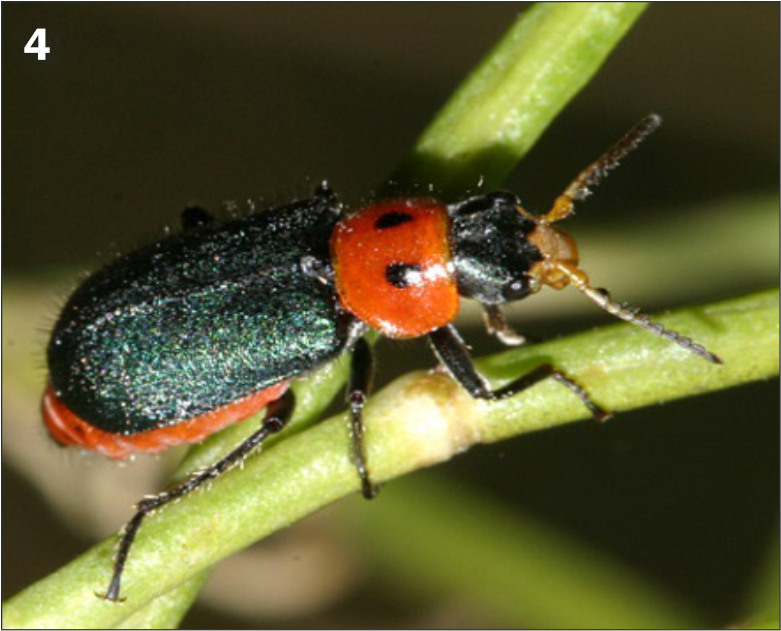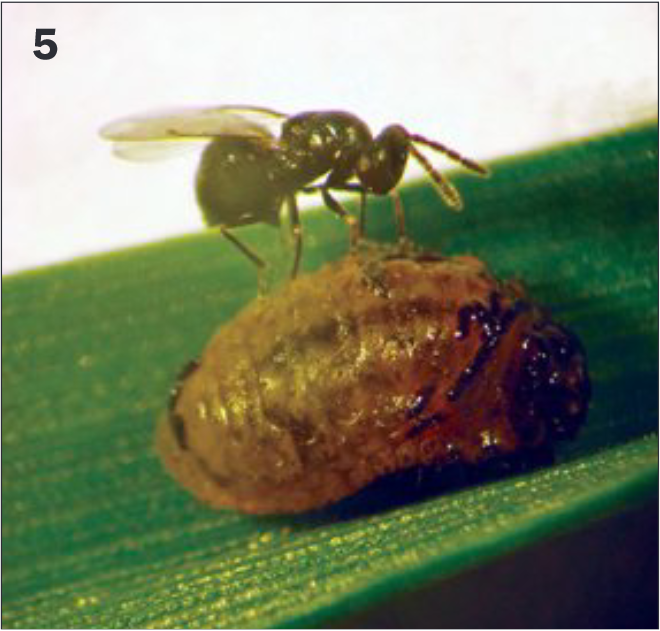
Pest Fact Sheets: Cereal Leaf Beetle
Cereal leaf beetle larvae are severe recurrent pests of wheat and other small grains, impacting yield and grain quality.
Last Updated: 02/16by Kevin Wanner, Associate Professor, Plant Sciences and Plant Pathology, and Ruth O'Neill, Research Associate, Plant Sciences and Plant Pathology
Species name:
Oulema melanopus (L.) (Coleoptera: Chrysomelidae)
Appearance:
Adults (~³⁄16" long) have shiny, metallic dark green wing covers and dark heads, long bead-like antennae, red legs, and red thoraxes (region behind the head) (Figure 1). Larvae (~³⁄16" long) have a slug-like appearance due to a shiny, wet droplet of mucous and fecal pellets coating the body (Figure 2A).
Host range:
The cereal leaf beetle has a broad host range, including barley, wheat, oats, and rye, where the larvae can cause serious damage. Adults are found feeding on small grains, corn, and sorghum but do not cause significant damage. Adult beetles are also found on many grassy weeds, including wild oats, quackgrass, timothy, canary grass, reed canary grass, annual and perennial ryegrass, foxtail, orchard grass, wild rye, smooth brome, and fescues.
Geographic range:
A native of Eurasia, cereal leaf beetle first appeared in the mid-western U.S. in the 1960s and has since spread throughout much of the U.S. Cereal leaf beetle is now well established in several areas of the North American wheat belt, particularly in Montana, North Dakota, and adjacent areas of the Canadian prairie-provinces.
Damage:
The larvae are the important damaging stage. Larvae feed mainly on the upper surface of tender new leaves, scraping the leaf tissue away in long, narrow, parallel strips without chewing all the way through the leaf. Feeding causes white streaks on the leaves (Figure 2B). As a result, photosynthesis is reduced. Severely damaged fields appear frosted. Adults feed on the leaves of young plants early in the spring, but damage is light (Figure 3).

FIGURE 1. Adult cereal leaf beetle has a red thorax, red legs, dark head and metallic green wing covers.


FIGURE 2. A) Cereal leaf beetle larvae coat themselves with a droplet of mucous and fecal pellets; B) Feeding causes parallel white streaks on leaves.
Not to be confused with:
Collops beetles are beneficial predators on soft-bodied pests such as aphids and caterpillars. Adult collops beetles are similar in size and appearance to cereal leaf beetles, and are easily confused with them. Like cereal leaf beetles, they have long antennae, metallic green wing covers, and red abdomens and thoraxes. Collops beetles differ in having shorter wing covers than cereal leaf beetles exposing the tip of the red abdomen, and their legs are not red. A common species in Montana is the two-spotted melyrid, Collops bipunctatus, which has a thorax marked with two black spots. The larvae of collops beetles are predatory like the adults, and they look nothing like cereal leaf beetle larvae.
Life cycle:
There is one generation per year. The adult beetles overwinter in crop stubble and other protected areas in or around fields. Early in the spring after mating, female beetles lay one or several yellow eggs on the upper sides of leaves, often in the mid-fold; females lay eggs (Figure 3) for up to two months after mating. Larvae hatch and begin feeding from mid-May to June in winter wheat while in spring wheat larvae appear somewhat later, beginning in mid-June. Fully developed larvae drop from the plants and burrow one or two inches into the soil to pupate, with adults emerging about two weeks later.
Management:
There are several species of beneficial insects including tiny chalcid wasps, some introduced intentionally from Europe, that attack either the eggs or larvae of the cereal leaf beetle. Tetrastichus julis, an internal parasite of cereal leaf beetle larvae, is now well established in several western states and can kill a substantial number of cereal leaf beetle larvae. Certain cultural practices have important effects on local parasitoid establishment and success. Plowing and disking of fields is damaging to parasitoid pupae, although some areas have successfully maintained established populations in spite of cultivation. Plants with multiple small flowers can be provided along field edges and waterways, providing an important nectar source for adult parasitoid wasps. Pesticide applications can depress parasitoid activity dramatically.

FIGURE 3. Adult chewing damage and eggs.

FIGURE 4. Look-alike collops beetles are beneficial predators in wheat and other crops.

FIGURE 5. Tetrastichus julius larvae are internal parasites of the cereal leaf beetle.
Economic threshold for insecticide application
The boot stage is important for developing cereal crop yield and quality, and the economic threshold for cereal leaf beetle damage depends on the plant stage. Feeding damage to young plants by the larvae has a negative effect on plant vigor. At the boot stage however, larval feeding is concentrated on the on the flag leaf, and this damage can directly impact grain yield and quality.
- Before the boot stage the threshold for insecticide application is three eggs and/or larvae per small plant and three eggs and/or larvae or more per stem/tiller of larger plants.
- After the boot stage the threshold for insecticide application is one or more larvae per flag leaf.
Examine 10 plants in one location and select one location for every 10 acres of field. Before the boot stage calculate the average number of eggs and/or larvae found per small plant or per single stem/tiller of larger plants. After the boot stage calculate the average number of larvae per flag leaf.
Additional resources
High Plains IPM Guide http://wiki.bugwood.org/HPIPM:Cereal_Leaf_Beetle
Cereal leaf beetle adult feeding damage and eggs, www.youtube.com/watch?v=OTJgO-zECKI
Cereal leaf beetle adult feeding damage and mating adults, www.youtube.com/watch?v=K0_QWXOWQ8o
IMAGE CREDITS - 1. John Rosenfeld©; 2. A) Carmen Champagne, B) Mourad Louadfel, Bugwood.org; 3. Agriculture Canada; 4. Tom Murray; 5. Swaroop Kher, University of Alberta, Edmonto

